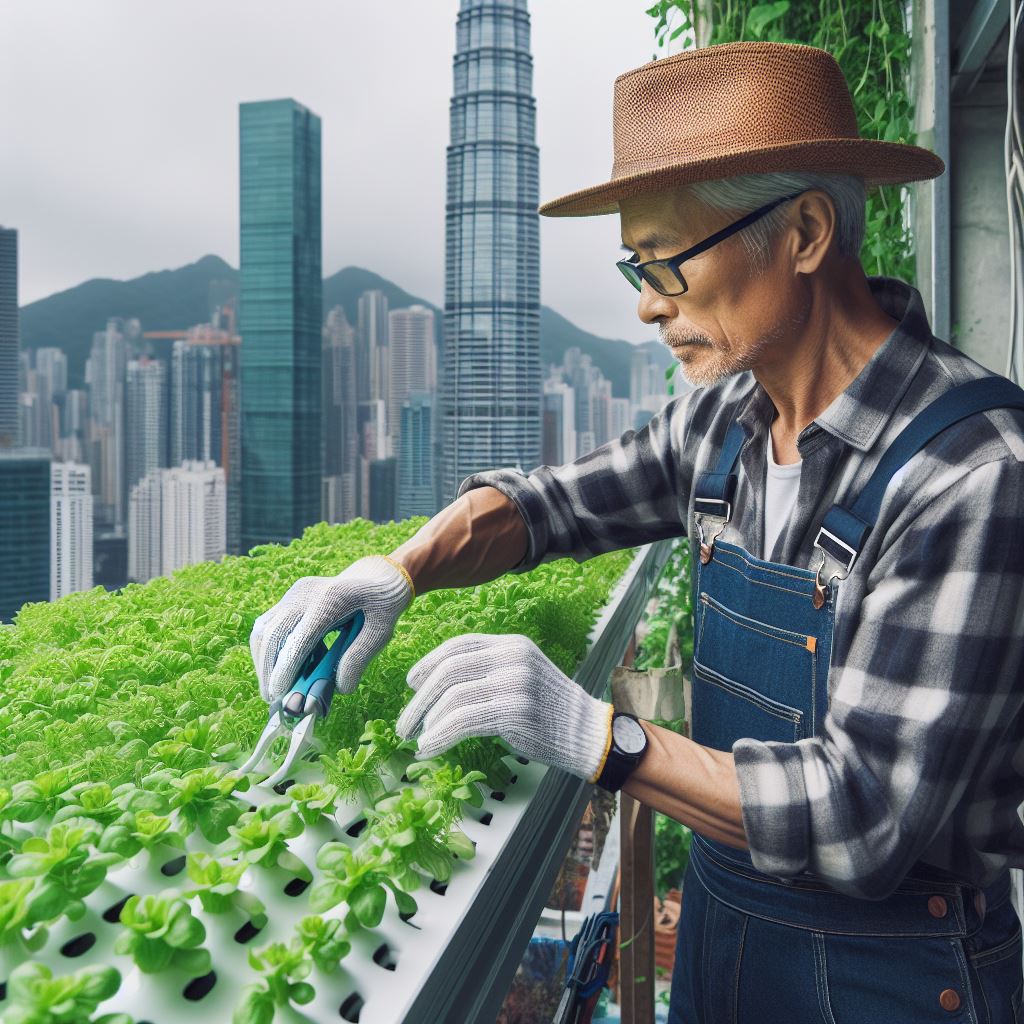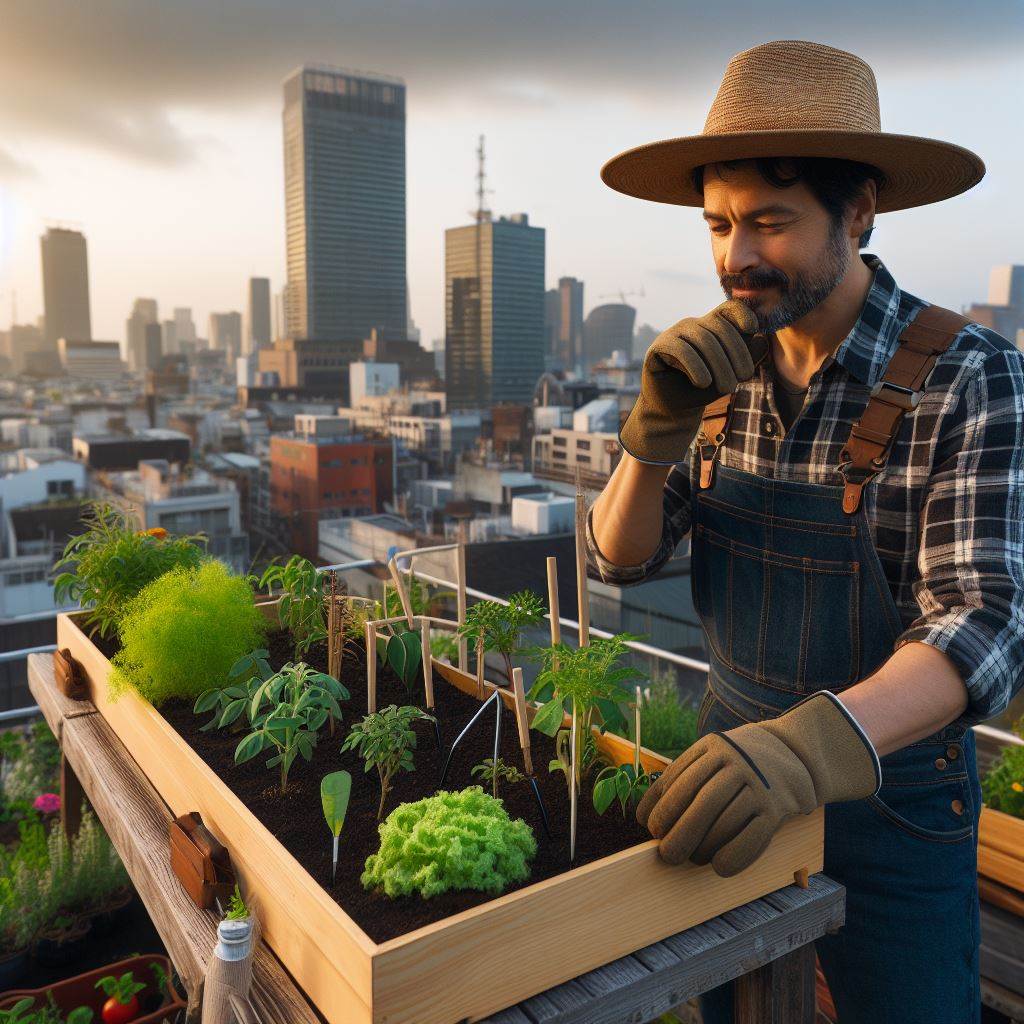Introduction
Definition of vertical farming
The definition of vertical farming is the cultivation of plants in a controlled environment, such as a skyscraper or warehouse, where the plants grow vertically instead of horizontally.
By utilizing hydroponics or aeroponics, crops can thrive entirely without soil, in nutrient-rich water or air.
Brief history and development of vertical farming
The concept of vertical farming dates back to the Hanging Gardens of Babylon, but its modern form began to develop in the early 20th century.
In recent years, advancements in technology, such as LED lighting and automation, have propelled vertical farming to new heights.
Importance and benefits of vertical farming
Vertical farming offers numerous benefits, including increased crop productivity, water conservation, and reduced transportation costs.
By growing crops closer to urban areas, it reduces the distance food needs to travel, thus minimizing carbon emissions.
This innovative approach to agriculture also eliminates the need for pesticides and herbicides.
The controlled environment allows for precise monitoring and adjustments to optimize plant growth and prevent disease outbreaks.
Additionally, vertical farming brings farming closer to consumers, fostering a stronger connection between people and their food.
It promotes local food security and reduces the reliance on traditional farming methods, which are vulnerable to climate change and natural disasters.
Basically, vertical farming is an exciting and sustainable solution that holds immense potential for addressing the challenges of feeding a growing global population.
With its numerous benefits, vertical farming is scaling new heights in revolutionizing our food systems.
Advantages of Vertical Farming
Vertical farming is revolutionizing the way we cultivate crops by utilizing unused vertical spaces.
This innovative agricultural technique offers several advantages that can enhance sustainability and food production while addressing the challenges associated with traditional farming methods.
Efficient space utilization
One of the most significant benefits of vertical farming is efficient space utilization.
Transform Your Agribusiness
Unlock your farm's potential with expert advice tailored to your needs. Get actionable steps that drive real results.
Get StartedBy growing plants vertically instead of horizontally, farms can make the most out of limited land availability.
Stacking crops in multiple layers enables farmers to produce a considerable quantity of food in a smaller area, making vertical farming an ideal solution for densely populated urban areas.
Year-round crop production
Moreover, vertical farming allows for year-round crop production regardless of seasonal changes or adverse weather conditions.
In traditional farming, crops are susceptible to various environmental factors that can damage or destroy them.
However, indoor vertical farms provide a controlled environment where temperature, humidity, and lighting can be optimized, ensuring optimal growth throughout the entire year.
Reduced water usage
A major issue affecting conventional agriculture is water scarcity.
Vertical farming significantly combats this problem, as it requires reduced water usage compared to traditional methods.
By implementing advanced irrigation techniques such as hydroponics or aeroponics, farmers can provide precise amounts of water directly to plant roots, minimizing waste and improving overall efficiency.
Minimal use of pesticides and fertilizers
Furthermore, vertical farming promotes sustainability by minimizing the use of pesticides and fertilizers.
The controlled environment in indoor farms helps prevent the spread of pests and diseases, reducing the need for chemical interventions.
This not only ensures healthier and safer produce but also contributes to a cleaner and more sustainable agricultural system.
Local food production and reduced transportation costs
In addition to its ecological benefits, vertical farming also offers economic advantages.
By establishing farms within or near urban areas, the transportation costs associated with traditional agriculture can be significantly reduced.
Local food production eliminates the need for long-distance transportation, ensuring fresher produce reaches consumers while lowering carbon emissions associated with transportation logistics.
Essentially, vertical farming presents a promising solution to many challenges faced by traditional agriculture.
Its efficient space utilization, year-round crop production, reduced water usage, minimal use of pesticides and fertilizers, and local food production contribute to a more sustainable and resilient food system.
With continuous advancements in technology and increased awareness about the benefits of vertical farming, we can expect its widespread adoption and integration into our future food production systems.
Read: Aquaponics in Cities: A Green Wave
Techniques and methods used in vertical farming
Vertical farming refers to the practice of growing crops in vertically stacked layers, often in urban environments.
This innovative approach to agriculture offers several advantages, including increased crop yield, efficient land use, reduced water consumption, and minimized pesticide use.
To achieve these benefits, various techniques and methods are employed in vertical farming.
Hydroponics
Hydroponics is one such technique commonly used in vertical farming.
It involves growing plants without soil, using nutrient-rich water solutions instead.
This method allows for precise control over the nutrients provided to the plants, ensuring optimal growth and yield.
Showcase Your Farming Business
Publish your professional farming services profile on our blog for a one-time fee of $200 and reach a dedicated audience of farmers and agribusiness owners.
Publish Your ProfileAdditionally, hydroponics conserves water since it requires only a fraction of the amount used in traditional soil-based farming.
Aeroponics
Aeroponics takes hydroponics to the next level by suspending the plant roots in air and misting them with nutrient solutions.
This method maximizes oxygen availability to the roots, resulting in faster growth and higher yields.
It is particularly suitable for vertical farming due to its efficient use of space and resources.
Aquaponics
Aquaponics combines hydroponics with aquaculture, creating a mutually beneficial system.
Fish or other aquatic animals are reared in tanks, and their waste provides nutrients for the plants.
The plants, in turn, filter the water for the fish, creating a sustainable cycle.
This symbiotic relationship minimizes the need for additional fertilizers and ensures efficient nutrient utilization.
Controlled environment agriculture
Controlled environment agriculture (CEA) refers to the creation of ideal conditions for plant growth by manipulating factors such as temperature, humidity, light, and CO2 levels.
Vertical farming utilizes CEA to maintain optimal growing conditions throughout the year, independent of external weather variations.
This approach allows for year-round production and the cultivation of crops that would otherwise be limited to specific seasons.
Artificial lighting and automated systems
Another crucial aspect of vertical farming is the use of artificial lighting and automated systems.
Since natural sunlight may be limited in indoor environments, artificial lighting provides the necessary light spectrum for optimal plant growth.
LED lights are commonly used in vertical farms due to their energy efficiency and customizable spectrum.
Automated systems, such as sensors and robotics, enable precise monitoring and control of environmental conditions, reducing labor requirements and ensuring consistent crop quality.
In general, vertical farming incorporates various techniques and methods to maximize crop yield and efficiency while minimizing resource consumption and environmental impact.
Hydroponics, aeroponics, and aquaponics enable soil-less cultivation, efficient nutrient utilization, and sustainable integration of fish and plants.
Controlled environment agriculture ensures year-round production regardless of external conditions, while artificial lighting and automated systems offer precise control and reduced labor.
As the world faces increasing food demand and limited land availability, vertical farming holds enormous potential to provide sustainable and scalable solutions for future agricultural needs.
Read: Regenerative Agriculture 101
Challenges and Limitations of Vertical Farming
Vertical farming, despite its numerous benefits and potential, also faces several challenges and limitations.
High Initial Investment and Operational Costs
Setting up a vertical farm requires significant capital investment and ongoing operational expenses for lighting, irrigation, climate control, and equipment maintenance.
Limited Crop Variety and Yield
Vertical farming is currently more suitable for growing leafy greens and herbs, but it poses challenges for cultivating large fruit-bearing crops.
Energy Consumption
The vertical farming system heavily relies on artificial lighting and climate control systems, leading to high energy consumption.
Finding sustainable energy sources is crucial for its long-term viability.
Need for Specialized Knowledge and Skills
Operating a vertical farm demands technical expertise in hydroponics, lighting systems, plant nutrition, and disease management.
A lack of skilled labor can be a major hurdle.
Regulatory Hurdles and Public Acceptance
Vertical farming must overcome regulatory challenges related to zoning, land use, and food safety regulations.
Additionally, public acceptance and perception of vertical farming practices may influence its adoption.
Space and Structural Limitations
Vertical farms require suitable infrastructure, such as tall buildings or stacked growing systems, which may not be easily available or affordable in all locations.
Scale and Efficiency
Despite advancements, large-scale vertical farming operations are still relatively limited, and achieving cost-effective scalability remains a challenge.
Water Usage and Management
Vertical farming relies on efficient water usage and recycling to minimize waste.
Implementing advanced irrigation systems and water management strategies is critical to address this limitation.
Pest and Disease Control
Intensive indoor farming in a controlled environment does not eliminate the risk of pests and diseases.
Proactive measures must be taken to prevent and manage these challenges.
Economic Viability
The overall profitability and return on investment of vertical farms need to be carefully evaluated and improved to ensure long-term economic stability.
While vertical farming shows immense promise for sustainable food production in urban areas, these challenges and limitations must be addressed through technological advancements, research, and strategic planning to maximize its potential.
Read: Food Miles: An Eco Concern
Recent innovations and advancements in vertical farming
Vertical farming has come a long way in recent years, with exciting advancements pushing the boundaries of what is achievable.
One major breakthrough is the development of efficient LED lighting systems, which are essential for indoor vertical farms.
Showcase Your Farming Business
Publish your professional farming services profile on our blog for a one-time fee of $200 and reach a dedicated audience of farmers and agribusiness owners.
Publish Your ProfileThese lighting systems provide the perfect spectrum for plant growth while minimizing energy consumption and heat generation.
Another innovation is the use of hydroponic and aeroponic systems, eliminating the need for soil and maximizing yield per square foot.
These soil-less techniques enable farmers to grow crops vertically, stacked on top of each other, increasing productivity exponentially.
Vertical farms in urban landscapes
One of the main advantages of vertical farming is that it allows crops to be grown in urban areas.
With the world’s population increasingly shifting to cities, this is a game-changer for food production and sustainability.
Vertical farms can be built vertically, utilizing underutilized spaces such as abandoned buildings or old warehouses.
This solves two problems simultaneously, revitalizing unused urban spaces and providing fresh produce locally.
Integration of renewable energy sources
Vertical farming has the potential to significantly reduce energy consumption in agriculture.
By integrating renewable energy sources, such as solar panels and wind turbines, farms can become self-sufficient and eco-friendly.
This not only reduces the carbon footprint but also makes vertical farming more economically viable in the long run.
The use of IoT and big data analytics
Vertical farms are embracing digital technologies, utilizing the Internet of Things (IoT) and big data analytics.
These technologies enable farmers to monitor and automate various aspects of the farm, including temperature, humidity, and nutrient levels.
Real-time data analysis helps optimize crop growth, resulting in higher yields and better resource management.
Vertical farming in unconventional spaces (e.g., skyscrapers)
The vertical farming revolution goes beyond traditional farming spaces, venturing into unconventional areas like skyscrapers.
With limited land availability, building farms vertically in high-rise buildings offers a unique solution.
These vertical farms can take advantage of natural light available at different building heights, reducing the need for artificial lighting.
Collaboration with restaurants and chefs for specialty crops
Vertical farming opens up exciting opportunities for collaboration between farmers, restaurants, and chefs.
Restaurants can work directly with vertical farms to grow specialty crops specifically tailored to their menus and unique customer preferences.
This not only ensures a fresh and customized supply of ingredients but also supports local businesses and reduces the carbon footprint of transportation.
In essence, vertical farming is scaling new heights with recent innovations and advancements.
From utilizing renewable energy sources to embracing digital technologies and collaborating with local businesses, the potential of vertical farming is limitless.
As our world continues to urbanize, vertical farming offers a sustainable and efficient solution to feed the growing population.
Read: Heirloom vs Hybrid Produce

Examples of successful vertical farming ventures
Vertical farming has gained significant attention in recent years as a sustainable solution to address food scarcity and environmental concerns.
This innovative approach, which involves cultivating crops in vertically stacked layers, is revolutionizing agriculture and transforming urban landscapes worldwide.
Several successful vertical farming ventures have emerged, providing valuable insights into the potential of this technology.
Let us explore some of these trailblazing examples:
Plenty, Inc. (San Francisco, USA)
Spearheaded by Nate Storey, this vertical farming company combines the expertise of plant scientists, engineers, and data analysts.
They utilize hydroponic systems, where plants are grown in nutrient-rich water without soil, to achieve optimal crop production.
Plenty, Inc. focuses on cultivating leafy greens, herbs, and other high-demand crops in their vertical farms.
Their cutting-edge technology enables year-round production, reduces water usage by 95%, and eliminates the need for harmful pesticides.
Sky Greens (Singapore)
As a pioneer in tropical vertical farming, Sky Greens has successfully harnessed the potential of urban agriculture.
They employ a system called A-Go-Gro, where plants rotate on a vertical tower to ensure equal exposure to sunlight and maximize growth.
By utilizing green walls and rooftops, Sky Greens optimizes limited urban space to meet increasing food demands.
Additionally, their closed-loop system efficiently recycles water, minimizing waste and environmental impact.
AeroFarms (Newark, USA)
AeroFarms leverages aeroponics, a technique that cultivates plants in a mist-like environment, to develop one of the world’s largest indoor vertical farms.
Their state-of-the-art facility utilizes LED lights tailored to specific plant requirements, resulting in faster growth and higher yields.
AeroFarms operates their vertical farm in a highly controlled environment, optimizing nutrient delivery, humidity, and temperature.
This precision agriculture approach enables them to conserve resources, reduce transportation costs, and bring fresh produce to local communities.
The success of these ventures highlights the tremendous potential of vertical farming to revolutionize food production and promote sustainability.
Showcase Your Farming Business
Publish your professional farming services profile on our blog for a one-time fee of $200 and reach a dedicated audience of farmers and agribusiness owners.
Publish Your ProfileAdvantages of vertical farming compared to traditional agricultural practices
Moreover, vertical farming offers numerous advantages compared to traditional agricultural practices:
- Increased Crop Yield: Vertical farming maximizes space utilization by utilizing multiple layers, enabling higher production per square foot compared to conventional farming methods.
- Year-Round Harvests: By providing a controlled environment, vertical farms can produce crops continuously, eliminating seasonal limitations.
- Water Conservation: Vertical farming employs innovative irrigation systems that significantly reduce water consumption compared to conventional farming, addressing the global water scarcity crisis.
- Reduced Carbon Footprint: With localized production and minimal transportation requirements, vertical farming reduces greenhouse gas emissions associated with long-distance food distribution.
- Enhanced Food Security: By enabling local food production, vertical farming reduces reliance on imported produce and ensures a more resilient and secure food supply chain.
- Economic Opportunities: Vertical farming has the potential to create new jobs in urban areas, driving economic growth and revitalizing communities.
- Biodiversity Preservation: Vertical farming minimizes the need for deforestation and land conversion, protecting ecosystems and preserving natural habitats.
As vertical farming continues to evolve, it holds the promise of transforming agriculture on a global scale.
While challenges such as high initial costs, energy consumption, and limited crop variety remain, ongoing technological advancements and increasing investment in research and development are rapidly addressing these barriers.
The expansion of vertical farming will contribute to sustainable development, ensuring a future where cities can provide their inhabitants with fresh, nutritious, and locally grown produce.
Future prospects and potential of vertical farming
Vertical farming is a revolutionary concept that has gained significant attention in recent years.
With the growing global challenges of food security and sustainability, this innovative method of agriculture presents promising future prospects and potential.
Expansion of vertical farming globally
One of the key advantages of vertical farming is its scalability.
Unlike traditional farming methods, vertical farms can be easily expanded to meet the increasing demand for food globally.
The controlled environment allows for year-round production and higher crop yields, making it a highly efficient and productive solution.
Role in addressing food security and sustainability issues
Furthermore, vertical farming has the potential to address food security issues.
As the world’s population continues to grow, the demand for food will rise exponentially.
Vertical farms can alleviate this pressure by producing food in urban areas, reducing the distance between production and consumption.
Not only does vertical farming help address food security, but it also contributes to sustainability.
By utilizing innovative technologies like hydroponics and aeroponics, vertical farms use significantly less water and land compared to traditional farming methods.
Additionally, the controlled environment minimizes the need for pesticides and herbicides, making it an eco-friendlier option.
Integration with smart cities and urban planning
Vertical farming also offers integration opportunities with smart cities and urban planning.
With the ongoing development of smart technologies, vertical farms can be seamlessly incorporated into urban landscapes, enabling efficient food production and reducing the reliance on external sources.
Collaboration with traditional farming methods
It is worth mentioning that traditional farming methods still play a crucial role in meeting the global food demand.
Vertical farming should be seen as a complementary approach rather than a replacement.
Collaboration between vertical farms and traditional farms can lead to a more sustainable and resilient food system.
Research and development in crop genetics and cultivation techniques
Research and development in crop genetics and cultivation techniques are essential for the advancement of vertical farming.
Genetic modifications can enhance plant resilience, improve crop yield, and even enable the cultivation of non-traditional crops.
Investing in these research efforts can further unlock the potential of vertical farming.
In a nutshell, vertical farming holds great promise for the future of agriculture.
Its scalability, contribution to food security and sustainability, integration with smart cities, collaboration with traditional farming methods, and ongoing research and development make it a vital component of our quest for a more secure and sustainable food system.
Conclusion
Vertical farming offers numerous benefits such as increased food production, resource efficiency, and climate resilience.
It also holds immense potential for growth and innovation in agriculture.
To fully tap into these advantages, further research and investment in vertical farming are crucial.
This revolutionary farming method has the ability to transform the way we produce food and address the challenges of feeding a growing global population.
With continuous advancements and support, vertical farming can become a sustainable solution to secure our future food supply.
Let us continue to explore and invest in this promising field for a more sustainable and resilient agricultural future.




